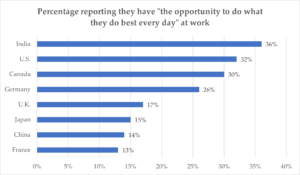Many people are disengaged at work and not energized and thriving in their lives. One major reason is that they’re not using their strengths—the things they’re good at—regularly.
According to data from Gallup’s global client database, most people aren’t using their strengths every day at work. See the chart below.

Many of us are either working in areas of our weaknesses or focused on fixing our weaknesses instead of leveraging our strengths more in what we do. For example:
We’re doing things we’d rather avoid—perhaps things that bore us or make us feel weak or incompetent.
We keep trying things but don’t get traction on them and don’t seem to improve much.
We’re working on things even though we know others who are much better at them than we are.
We feel drained by the things we’re doing.
Could it be that we’re thinking about things the wrong way—focused on just doing what we’re told or what’s in front of us, or on shoring up our weaknesses to avoid looking bad, instead of actively crafting our work and activities in line with our strengths?
In their book, Living Your Strengths, Albert Winseman, Donald Clifton, and Curt Liesveld note the following:
“If you’re like most people, you have grown up with the ‘weakness prevention’ model. You’ve been told that to become strong, successful, or truly serve…you must ‘fix’ your weaknesses.…That thinking is just plain wrong.…
the evidence is overwhelming: You will be most successful in whatever you do by building your life around
your greatest natural abilities rather than your weaknesses.”
Enter strengths.
What Is a Strength?
Strengths are the things at which we most excel. According to English consultant and author Marcus Buckingham, “Your strengths are those activities that make you feel strong.”
In Living Your Strengths, Winseman, Clifton, and Liesveld define it as follows: “A strength is the ability to provide consistent, near-perfect performance in a given activity.” They conceive of a strength as a powerful, productive combination of innate talent, relevant knowledge, and skills.
“The fundamental building block of any strength is talent.
When you enhance a talent by adding the right skills and useful knowledge, you have created a strength.”
-Albert Winseman, Donald Clifton, and Curt Liesveld, Living Your Strengths
Let’s look at the three components of a strength in turn:
Talents, they write, “are naturally recurring patterns of thought, feeling, or behavior that can be productively applied.” Examples include a natural tendency to make people laugh, tune into others’ emotions, or thrive under pressure. These talents naturally exist within us as our inborn predispositions (unlike knowledge and skills). We do them instinctively and derive satisfaction in the process.
“The man who is born with a talent which he was meant to use finds his greatest happiness in using it.”
-Johann Wolfgang Goethe, German poet, novelist, and scientist
Knowledge is what we know—whether factual or experiential knowledge. We can acquire knowledge through various means, from reading and courses to conversations and challenges. Ideally, we have a learning mindset and continually look for new ideas and methods.
Skills, they note, “are the abilities to perform the steps of an activity.” Examples include preparing seminars, presentations, or lesson plans. When we focus on developing our skills, we can boost performance significantly.
Talents, knowledge, and skills are the fundamental building blocks of strengths, but there are other relevant factors that influence their development. Such other factors include practice, coaching, repetition, and feedback. When we do things repeatedly and get targeted guidance and feedback on how we’re doing, we can really amp up our performance.
In his book, Strengths Finder 2.0, consultant and author Tom Rath notes that there’s incredible room for growth when we focus on developing our natural talents. He says it’s not realistic to be anything we want to be, as the saying goes, but we can be a lot more of who we already are. By building on our innate talents and interests, we can make incredible strides and thrive.
The Benefits of Knowing and Using Our Strengths
There are tremendous benefits to knowing and using our strengths in our work and daily lives, according to researchers. For example, knowing and using our strengths can:
- enhance our confidence and help us overcome self-doubt (and keep our negative self-talk in check)
- boost our motivation and engagement dramatically (1)
- increase our productivity
- give us more clarity about how we’re likely to succeed
- help us achieve our goals
- set us up for more opportunities for advancement
- make us happier and more fulfilled
- help us avoid burnout
“Burnout doesn’t happen when you are working long hours on invigorating activities. Long hours may tire you out, but they rarely burn you out. But fill your weeks with the wrong kinds of activities, activities that weaken you,
and even regular activities will start to burn.”
-Marcus Buckingham, Go Put Your Strengths to Work
There’s also a flip side to this: there’s much lost when we don’t use our strengths. When we’re not operating in our strengths zone, according to Rath, we’re much more likely to be disengaged at work. We may even dread it. We’re more likely to have more negative interactions with colleagues, treat customers poorly, and achieve less.
The Signs of a Strength
Unfortunately, we tend to take our strengths for granted. In some cases, they’re so much a part of our daily lives that they’ve become invisible to us. We’re not aware that others may struggle with the things that come easily to us because we’ve been swimming in our strengths for so long.
So, what are the signs of a strength? In his book, Go Put Your Strengths to Work, Marcus Buckingham identified four signs of a strength, using the acronym SIGN (Success, Instinct, Growth, Needs):
Success: the things we do that make us feel successful. We’ve received recognition or praise for these things.
Instinct: the things we find ourselves drawn to, even if we’re not sure why. We’d like to do them every day, and we may volunteer for them spontaneously.
Growth: the things that were simpler for us to pick up and develop over time. We don’t have to try very hard when we do them. Also, we stay focused on them naturally and lose track of time when doing them.
Needs: the things that fill an innate need of ours and that leave us feeling powerful, fulfilled, and restored instead of drained. We feel a need to do them, and they give us a lot of personal satisfaction.
In sum, our strengths make us feel successful, draw us to use them, are relatively easy for us to develop, and fill a need of ours. We also feel energized while using them.
Signature Strengths
University of Pennsylvania psychologist Martin Seligman, former president of the American Psychological Association, writes about what he calls “signature strengths,” which he defines as “strengths of character that a person owns, celebrates, and frequently exercises.” They’re essential to who we are, and they tend to give us the following:
- rapid learning curve as they’re first practiced
- feeling of excitement while using them
- sense of authenticity (“This is the real me”)
- desire to learn or find new ways to use them
- feeling of enthusiasm and invigoration rather than exhaustion while using them
- desire to pursue projects that revolve around them
To determine our strengths, we can take assessments (see the resources at the end of this article), ask those who know us well (perhaps via a 360-Degree Assessment), and/or observe our own experiences and ask ourselves questions like the following:
When have I achieved success, and what strengths did I use in the process?
What things do others come to me for help with because I’m good at them?
How have I overcome significant challenges, and what strengths did I use in the process?
How to Leverage Our Strengths in Our Life and Work
Here are nine steps for leveraging our strengths effectively in our life and work:
- Know what our strengths are.
- Clarify how and when our strengths help us with our most important work.
- Measure how much time we’re using our strengths (e.g., over the past week).
- Set goals for how much time we’ll do so in the future (e.g., over the next week).
- Decide what actions we’ll take to use our strengths.
- Create a plan for how we’ll develop our top strengths further with new knowledge or skills.
- Determine what we’ll do to reduce the amount of time we’re working in areas of our weaknesses. (It may not be possible to eliminate it altogether.) An important caveat: though we should generally avoid working in areas of weakness for us, that doesn’t mean that we should ignore our weaknesses. Knowing our weaknesses can be valuable.
- Seek colleagues who have different strengths and who compensate for our weaknesses.
- Continually seek ways to leverage our strengths in service of worthy endeavors that we’re passionate about.
It may also be helpful to have a coach because we’re often blind to our strengths. Others can often see our strengths more clearly and help us figure out ways to develop and use them more effectively.
How Leaders Can Leverage Strengths for High Performance
Strengths are also relevant for leaders and organizations. They can be a powerful performance booster. To begin with, leaders should know and use their own strengths in their work.
“I’ve never met an effective leader who wasn’t aware of his talents and working to sharpen them.”
-Wesley Clark, former NATO Supreme Allied Commander
Next, managers should pay close attention to strengths in people selection and advancement as well as in job and team design. The team overall should have a well rounded and complementary set of strengths. For example, a founding team in a startup can map out the skills of its current team members as well as the skills gaps it’s looking to fill with new hires. See the table below.

Third, leaders should ensure that all team members are using their strengths as much as possible.
“While there are many good levers for engaging people and driving performance… the master lever is getting each person to play to his strength. Pull this lever and an engaged and productive team will be the result.
Fail to pull it and no matter what else is done to motivate the team, it’ll never fully engage.”
-Marcus Buckingham, Go Put Your Strengths to Work
Finally, leaders should invest in the development of the strengths of everyone on the team (including themselves).
Conclusion
We’re all born with certain talents and interests, and we’re all drawn to certain activities and endeavors. If we can discover what we’re good at and build our life and work around those strengths, we can feel more engaged and energized, and we can thrive. And what if we applied our strengths toward a purpose or calling and used them to serve others in meaningful ways? That would be remarkable.
Reflection Questions
- What are your core strengths?
- To what extent are you using your strengths (at work, home, etc.)?
- Are you using them every day?
- How could you use your strengths more?
- What will you do differently, starting today?
Tools for You
- Strengths Search Tool to help you identify your core strengths and integrate them more into your life and work
- Traps Test (Common Traps of Living) to help you identify what’s getting in the way of your happiness and quality of life
- Quality of Life Assessment to help you discover your strongest areas and the areas that need work and then act accordingly
Related Articles
- “What Are Your Strengths–And How Can You Use Them More?”
- “A CEO Reflects on Using Different Strengths in Different Life Phases”
- “Why Self-Awareness Is So Important—And How to Develop It”
- “How to Discover Your Purpose”
- “How to Discover Your Core Values”
- “The Power of Integrating Our Passions into Our Life and Work”
- “Goal-Setting Practices: Beyond SMART Goals”
- “Tired of Settling? How to Set Your Life and Work on Fire”
Additional Resources
- Tom Rath, StrengthsFinder 2.0 (including an online assessment)
- Albert Winseman, Donald Clifton, and Curt Liesveld, Living Your Strengths
- Marcus Buckingham, Go Put Your Strengths to Work
- Tom Rath and Barry Conchie, Strengths Based Leadership (including an online assessment for a personalized leadership guide)
- Clifton Strengths Assessment
- VIA Survey of Character Strengths
Postscript: Inspirations on Strengths
- “Liberating and expressing your natural genius is your ultimate path to success and life satisfaction.” -Gay Hendricks, psychologist and author
- “Herein is my formulation of the good life: Using your signature strengths every day in the main realms of your life to being abundant gratification and authentic happiness.” -Martin Seligman, Authentic Happiness
- “A leader needs to know his strengths as a carpenter knows his tools, or as a physician knows the instruments at her disposal. What great leaders have in common is that each truly knows his or her strengths—and can call on the right strengths at the right time.” -Dr. Donald Clifton, psychologist and researcher
(1) According to Tom Rath in StrengthsFinder 2.0, workers who can focus on their strengths every day are “six times as likely to be engaged in their jobs and more than three times as likely to report having an excellent quality of life in general.”
++++++++++++++++++++++++++++++
Gregg Vanourek is a writer, teacher, and TEDx speaker on personal development and leadership. He is co-author of three books, including LIFE Entrepreneurs: Ordinary People Creating Extraordinary Lives (a manifesto on living with purpose and passion) and Triple Crown Leadership: Building Excellent, Ethical, and Enduring Organizations (a winner of the International Book Awards). Check out his Best Articles or get his monthly newsletter. If you found value in this article, please forward it to a friend. Every little bit helps!



